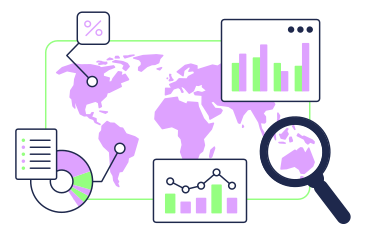Market research has always been essential for businesses to understand their audiences, predict trends, and create effective strategies. As industries evolve, so do the techniques used in market research analysis. Businesses are now relying on innovative approaches to keep up with customer needs and competitive landscapes. In this article, we will discuss the trends shaping market research today and how they impact businesses.
1. The Rise of Artificial Intelligence in Market Research
Artificial intelligence has transformed market research by automating processes and delivering faster results. Tools powered by artificial intelligence can analyze vast datasets, identify patterns, and provide actionable insights.
These systems make it possible to:
- Predict customer behavior by analyzing historical data.
- Segment audiences with greater precision.
- Simplify sentiment analysis across social media platforms.
For instance, artificial intelligence tools like chatbots are used in online surveys to interact with respondents in real time. This improves response rates and gathers more meaningful data. While artificial intelligence cannot replace human expertise, it enhances the accuracy and speed of market research efforts.
2. Real-Time Data Collection Is Changing the Game
The demand for real-time insights is reshaping how businesses approach market research. Traditional methods, such as focus groups or surveys, often take weeks to produce results. Real-time data collection methods, however, enable researchers to gather and analyze data instantly.
Some examples include:
- Tracking consumer activity on e-commerce platforms.
- Monitoring social media trends to understand consumer sentiment.
- Using heatmaps to observe customer interaction on websites.
Real-time data helps businesses make quick decisions and respond to trends as they happen, keeping them ahead in competitive markets.
3. Growing Popularity of Mobile Market Research
Mobile devices are now central to daily life, making them an effective tool for conducting research. Mobile surveys, app usage tracking, and location-based data collection provide deeper insights into consumer behavior.
Advantages of mobile market research include:
- Higher participation rates due to accessibility.
- Improved accuracy with features like GPS tracking.
- Quick feedback on products or services through mobile-friendly surveys.
By reaching people where they spend most of their time—on their phones—companies are collecting more relevant and timely data.
4. Social Media’s Influence on Market Research
Social media platforms have become a treasure trove of information for market research. Companies can observe trends, gauge public sentiment, and identify emerging consumer needs through these platforms.
Social listening tools allow researchers to track:
- Brand mentions across different platforms.
- Competitor performance by monitoring user interactions.
- Popular topics in specific demographic groups.
By analyzing this data, businesses can refine their marketing strategies and improve customer engagement. Social media analytics is now a cornerstone of modern market research.
5. Increased Focus on Ethical Research Practices
As data privacy concerns grow, ethical considerations are now central to market research efforts. Consumers are more aware of how their data is being used, and stricter regulations like the General Data Protection Regulation emphasize transparency.
Companies are adopting practices such as:
- Gaining explicit consent before collecting personal information.
- Using anonymized datasets to protect privacy.
- Clearly explaining how survey data will be used.
Ethical research not only builds trust with customers but also helps companies avoid legal issues.

6. Personalization in Data Analysis
Today’s consumers expect brands to understand their unique preferences. Personalization is becoming a significant trend in market research, with businesses focusing on tailored experiences.
By analyzing detailed customer profiles, researchers can:
- Identify individual preferences and buying behaviors.
- Recommend products or services based on past interactions.
- Develop personalized marketing campaigns.
Personalization enhances customer satisfaction and boosts brand loyalty, making it a win-win for businesses and their audiences.
7. The Role of Predictive Analytics
Predictive analytics is another trend transforming market research. This approach uses statistical models and algorithms to forecast future behaviors and outcomes.
Examples of predictive analytics applications include:
- Anticipating seasonal trends for inventory planning.
- Identifying potential customer churn and developing retention strategies.
- Optimizing pricing strategies based on demand forecasts.
This proactive approach allows businesses to stay ahead of market changes, improving their decision-making process.
8. Growing Use of Gamification in Surveys
Surveys can often feel boring or repetitive, leading to low response rates. Gamification is changing this by making surveys more engaging and interactive.
By incorporating game-like elements such as points, badges, or leaderboards, companies can:
- Encourage more participation.
- Collect higher-quality responses.
- Make the research process enjoyable for respondents.
Gamification not only improves the survey experience but also delivers more reliable data for analysis.
9. Integration of Blockchain Technology
Blockchain technology is gaining traction in market research as a secure and transparent method for managing data.
Key benefits include:
- Ensuring data authenticity and reducing fraudulent responses.
- Protecting personal information through decentralized systems.
- Offering incentives to participants using cryptocurrency rewards.
Blockchain ensures that data is trustworthy and reliable, fostering better outcomes for market research initiatives.
10. Emphasis on Emotional Intelligence in Analysis
Market research is now going beyond surface-level insights to focus on emotional intelligence. Understanding what motivates customers on an emotional level helps brands build deeper connections.
Methods to incorporate emotional intelligence include:
- Using facial recognition software to study reactions during product testing.
- Analyzing tone and sentiment in open-ended survey responses.
- Observing how emotions influence buying decisions.
Emphasizing emotions helps businesses develop campaigns that resonate with their audience on a deeper level.

11. Greater Dependence on Big Data: Market Research
Big data is no longer just a buzzword; it is a core component of market research. Companies are using massive datasets to uncover trends, track performance, and predict behaviors.
Sources of big data include:
- E-commerce transactions.
- Social media activity.
- Customer service interactions.
By processing and analyzing this data, businesses gain valuable insights to guide their strategies effectively.
12. Voice Technology as a Research Tool
Voice assistants like Amazon Alexa and Google Assistant are changing how people interact with technology. Market researchers are using these tools to gather insights through voice searches and commands.
Benefits of voice technology in research include:
- Identifying popular voice search queries for targeted marketing.
- Observing trends in voice-activated purchases.
- Enhancing accessibility for survey participants.
Voice technology provides a unique and untapped resource for gathering consumer insights.
13. The Importance of Cross-Channel Integration
Modern consumers interact with brands across multiple platforms, from social media to physical stores. Cross-channel integration allows researchers to track customer journeys seamlessly.
This method enables companies to:
- Understand how various channels influence purchase decisions.
- Create consistent messaging across all touchpoints.
- Identify gaps in the customer experience.
Cross-channel data provides a comprehensive view of consumer behavior, aiding in better decision-making.
14. Virtual Reality in Market Research
Virtual reality is making its way into market research, offering immersive experiences that allow companies to observe behavior in simulated environments.
Applications of virtual reality include:
- Testing store layouts and product placements.
- Conducting virtual focus groups.
- Observing customer reactions to new products.
This innovative approach provides insights that are often difficult to capture through traditional methods.

15. Shifting Consumer Expectations: Market Research
Consumer expectations are always evolving, and market research must adapt to these changes. Today’s customers value convenience, transparency, and personalized experiences more than ever.
To meet these expectations, researchers must:
- Stay updated on current trends.
- Use advanced tools to gather accurate insights.
- Focus on delivering value through their findings.
Understanding these shifts is key to staying relevant and competitive.
Conclusion: Market Research
Market research is evolving rapidly, driven by technological advancements and changing consumer behaviors. From artificial intelligence to ethical practices, these trends are shaping how businesses gather and analyze data. Staying informed and adaptable is essential for businesses looking to thrive in dynamic markets.








